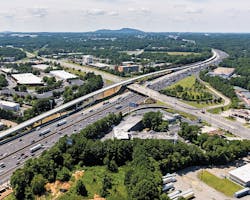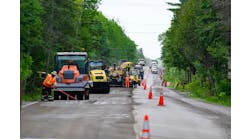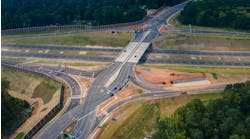It did not happen until the opening day of the Northwest Corridor Express Lanes in Atlanta, Ga., but Zach Folmar finally saw more than enough qualified people.
The lack of skilled workers is not a new trend in the road and bridge construction market, but activity in the Atlanta area double-knotted the labor pipeline when the Northwest Corridor Express Lanes project started in November 2013. With Sun Trust Park and Mercedes Benz Stadium construction already in full swing, the search for workers hit a patch of dense fog that refused to lift.
“We hired over a thousand people to keep a 400 average at the peak of construction, and a lot of those thousand skilled workers were new to construction,” Folmar, project director on the Northwest Corridor for Archer Western, told Roads & Bridges. “The demand for an actual skilled worker was astronomical.”
But on Sept. 11, the day the managed lanes opened to traffic for the first time, a couple of skilled drivers gave Folmar exactly what he was looking for, even though the project was, for the most part, finished. Folmar took a different route that day; he decided to enjoy what the team had built every day for five years.
“I got to a certain point [on the managed lanes] and I just got chills because I looked over to my left on two different occasions and someone that was riding beside me was smiling,” Folmar recalled. “I’m just so proud to be a part of this.”
The largest transportation project in Georgia history, the Northwest Corridor Express Lanes project consisted of just under 30 miles of reversible tolled pavement along I-75 and I-575 in Cobb and Cherokee counties in metro Atlanta, where officials have been battling for traffic space for decades. The project also included the design of six new express interchanges on I-75, new access points and 39 bridges with lengths totaling about 27,500 linear ft. Factor in the tight working space and environmental sensitivity, and there is no doubt as to why it was named the No. 1 project on Roads & Bridges’ 2018 Top 10 Roads list.
“It has been a long project,” Kevin Oswandel, who served as Hubbard’s senior project manager on the No. 1 job, told Roads & Bridges. “It’s pretty satisfying we got it done, and I think the state has a good road.”
They could barely move
As far as space goes, it also was a very tight project. Oswandel called the work zone a “small postage stamp area.” The I-285/I-75 interchange was perhaps the area workers were happy to finally lick when all was said and done. In order to create construction space, Archer Western/Hubbard had to move I-285 by widening the outside and dropping the managed lanes into the median.
The Georgia Department of Transportation also prohibited the joint venture from using the general-purpose lanes of the existing interchanges. Four separate access points, some created using isolated side roads, had to be constructed for the I-285 interchange alone, according to Oswandel.
Transporting equipment along the 30-mile project also had to be coordinated daily.
Accelerated and complicated
Accelerated bridge construction (ABC) was used throughout the new section, and the process paid for itself in two areas: Bridge 11 and Bridge 17.
Bridge 11 is a six-span bridge over the existing I-75 southbound lanes, and was constructed with very tight horizontal and vertical geometry controls. This required the construction of a straddle bent over three lanes of I-75 traffic. To minimize disruptions, a two-stage straddle bent cap solution was executed. First, crews placed precast, post-tensioned inverted tee pier caps and put up formwork during overnight closures. Then they constructed the top portion of the cap, which was cast-in-place concrete. The precast straddle bents were placed by a 300-ton Liebherr LTM 1300-6.2 hydraulic crane.
Bridge 17 is a 25-span I-75 express lane bridge located adjacent to and centered between Hope Creek and the existing southbound I-75 general-purpose lanes. Environmental credits had to be purchased for drilled shaft work in the creek bed area, and the joint venture had to work off the shoulder of the general-purpose lanes and execute top-down construction. Hammerhead pier caps were precast and also placed by a 300-ton Liebherr LTM 1300-6.2 hydraulic crane, which Folmar said was “a big win for us.”
The saddle bents and pier caps allowed the new bridges to take on a lower profile, which saved money and accelerated construction.
Settling in
Poor soil conditions were everywhere. Most of northern Georgia is within the Piedmont Geologic Formation, which is known for having unpredictable soil settlements. Settlement estimates across the site were typically 10 in. or more. Over 10 miles of mechanically stabilized earth walls were constructed, and Oswandel said it sometimes took almost two months to settle. The rock around Atlanta is volcanic and their location was unpredictable, making piling the drilled shaft operations difficult.
“You could go 100 ft away and not have any rock, and then all of a sudden you have this blob of rock that shows up and you have to manage through it,” said Oswandel.
Massive amounts of rock were around the I-575/I-75 interchange, requiring extensive blasting.
A side job
Concrete paving also was handled a little differently. Crews placed 12-in.-thick pavement, but the order of the slipform paving was changed due to the tight work space. After mainline paving was completed with a GOMACO GT6300 paver and GOMACO 9500 placer, crews would then construct the barrier wall separating the tolled lanes from the general-purpose lanes. This would allow lighting and intelligent transportation systems to be installed. Side drafting was then executed to pave the shoulder. Side drafting is when you pave a lane with the equipment parallel on the newly constructed lane. If the paving operation did reach a bridge that was not completed, equipment had to be pulled and reset on the other side. The mix, which consisted of 60% manufactured sand and 40% natural sand, reached a strength of 3,000 psi after about three days.
Location: Atlanta, Ga.
Owners: Georgia Department of Transportation, State Road & Toll Authority
Designer: Parsons Transportation Group
Contractors: Archer Western Contractors and Hubbard Construction Joint Venture
Cost: $599 million
Length: 29.7 miles
Completion Date: Aug. 31, 2018



